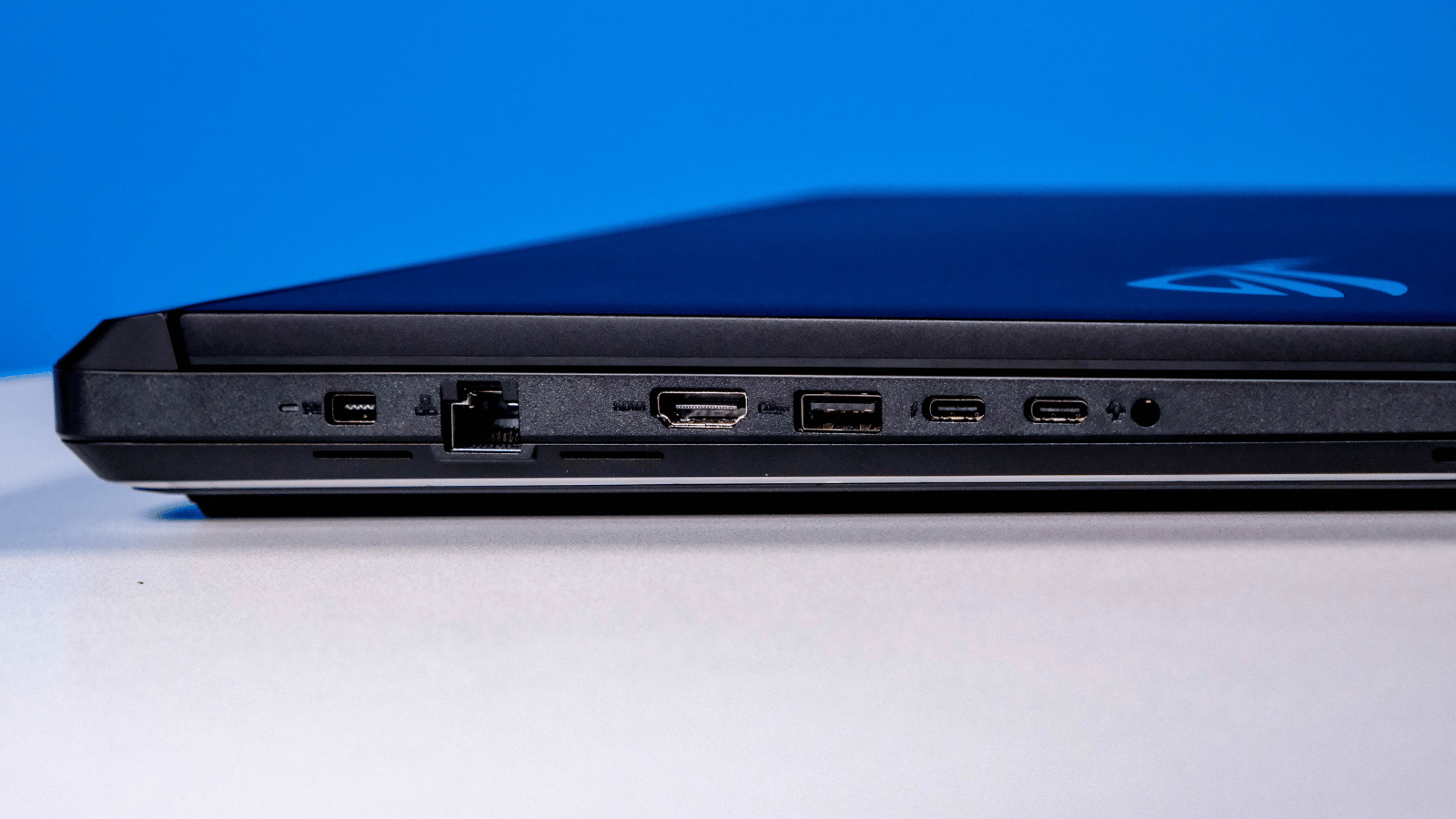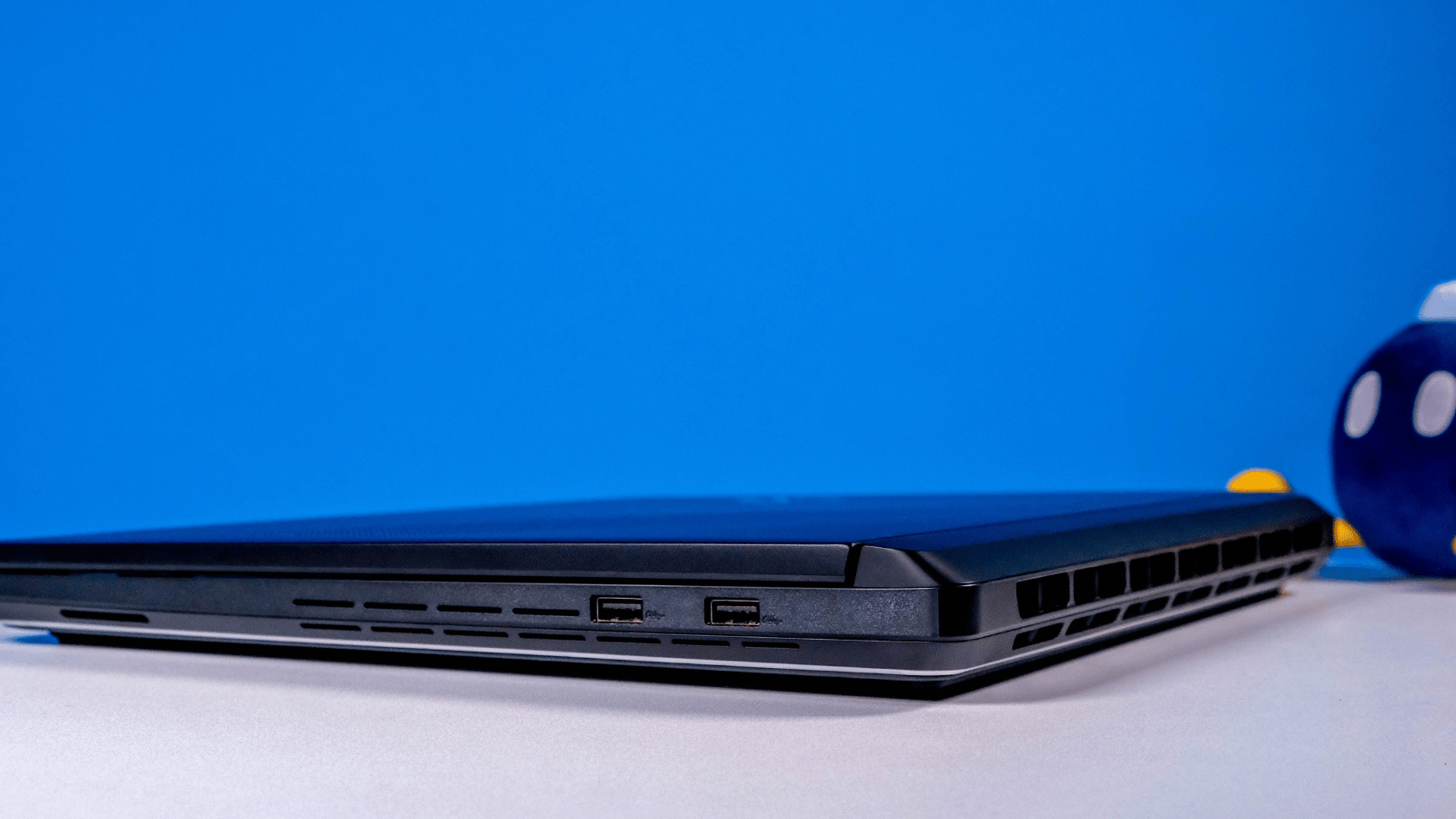Beastly
Asus has updated the ROG Strix Scar 18 with the latest chips from Nvidia and Intel and made a few design changes but it’s mostly the same package as the last few models. The 18in Mini-LED display is fantastic, the new chips offer some of the best performance you can get in a laptop, and it has plenty of RGB lighting. If you can stomach the R100K price tag, you won’t be disappointed with this relatively mobile gaming beast.
-
Design
-
Display
-
Performance
-
Features
-
Value
One look at the spec sheet for the new Asus ROG Strix Scar 18 (G835LX) was all we needed to know that it was going to be powerful. The 2025 model has been updated with the latest silicon from Nvidia and Intel, and also received a few design changes that we reckon work in its favour for a more refined look while still making it clear to anyone with eyes that you’re a gamer.
Our review model arrived sporting an Intel Core Ultra 9 275HX CPU, Nvidia RTX 5090 laptop GPU, 64GB of DDR5 RAM, two 2TB Gen 4 NVMe SSDs set up in RAID 0, and enough RGB to scare away a LAN party. Its price tag is similarly impressive at R100,000. That’s a lot of money by anyone’s standards, and Asus tries its best to justify it. But does it do enough?
Shiny lights
Asus has updated the design of its flagship Strix Scar 18 with the 2025 model. The visual changes aren’t a far cry from previous models, but give the new Scar 18 a more distinguished look. With the RGB disabled, this behemoth won’t look too out of place in a boardroom. The same can’t be said for you as you sit down, out of breath from lugging an 18in 3.3kg chunk of laptop around the office.
You will probably also get raised corporate eyebrows if you ever enable the RGB in the office. There’s a light bar that runs around the entire bottom edge of the chassis, which makes the Scar 18 seem to float on a bed of light in a dark room. Other RGB areas include the ROG logo on the display lid and customisable per-key RGB for the full-sized keyboard.
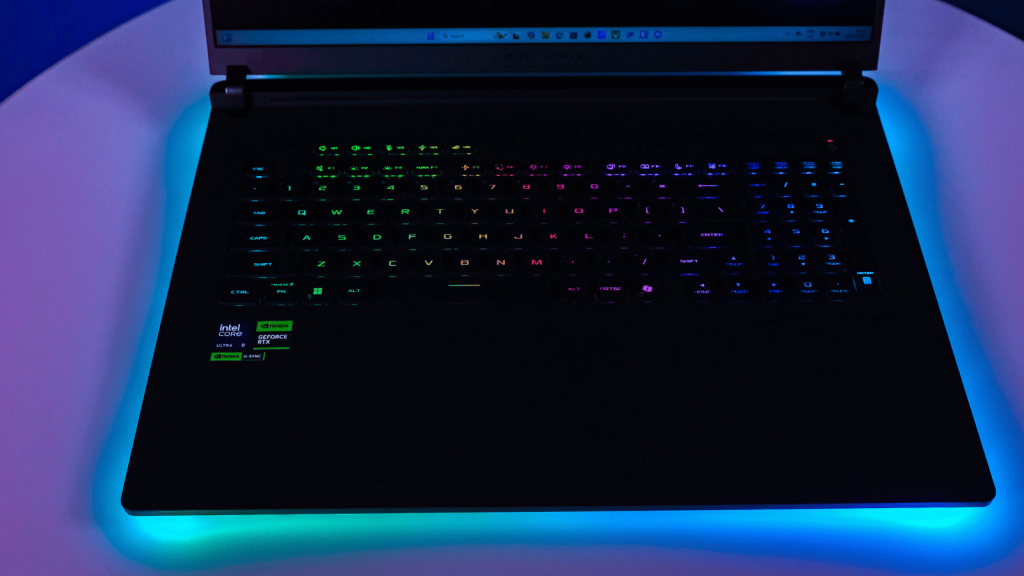
Due to the size of this laptop, the keyboard is quite spacious and comfy to type on with a decent amount of key travel. It’s not mechanical, but that means no one needs to put up with the clickety-clack that often accompanies mechanical keyboards. Similarly, the large glass track pad felt smooth with tactile clicks from its lower half.
Then there’s what Asus calls AniMe Vision. It’s a little display on the Scar 18’s lid made up of 810 LEDs and 9,152 holes, which you can customise with pre-made animations, downloaded GIFs, or something self-designed. Corporate jokes aside, if you’re a fan of expressing your creativity through tech, the Scar 18 makes that possible.
Imposing display
As you might’ve guessed from the name, the ROG Strix Scar 18 features an 18in display. Like last year’s model, this one features a Mini-LED panel. It boasts a 2,560 x 1,600px resolution with a 16:10 aspect ratio and a 240Hz refresh rate. It also comes with G-Sync compatibility, support for the Dolby Vision HDR format, and validation from Pantone.
This panel delivers excellent picture quality. The use of a Mini-LED panel means it can get way brighter than most OLEDs, with the added benefit of not worrying about screen burn-in. While the default colour profile looks a little over-saturated to our eyes, there are colour-accurate profiles for sRGB and DCI-P3. Motion is handled well thanks to the high refresh rate, and we didn’t notice any issues or visual artefacts due to slow pixel response times during our tests.
Asus has also put in the work in Armoury Crate to provide actually useful picture modes. There are three profiles in SDR mode that offer different max brightness levels, with one of them giving the option to disable local dimming. That’s particularly useful for the creative types doing image editing. It ensures uniform brightness across the screen.
For the HDR stans, there’s even a display option that automatically converts non-HDR content (like the Windows desktop) from the sRGB colour space to the wider P3 gamut so you can wave goodbye to constantly toggling HDR mode on and off. If you’d prefer to stick to SDR mode, we should mention we did notice a little backlight bleed when local dimming is active. This will make a black screen appear grey. If you aren’t tied to SDR, stick to HDR and you won’t be sorry.
Plugging in
As far as connectivity goes, there is a decent selection of ports, all of which are found along the left and right sides. The rear is reserved for expelling hot air. On the left, you’ll find the proprietary power connector that the substantial 380W power brick will connect to, as well as ports for 2.5Gb/s Ethernet, HDMI 2.1, and a 3.5mm audio combo jack.
Of the five available USB ports, you’ll find three on the left: 1x USB-A 3.2 Gen 2 (10Gb/s), 2x USB-C Thunderbolt 5 (120Gb/s). A further two USB-A 3.2 Gen 2 ports live on the right. For wireless connectivity, Wi-Fi 7 and Bluetooth 5.4 should do the trick.
Powering up
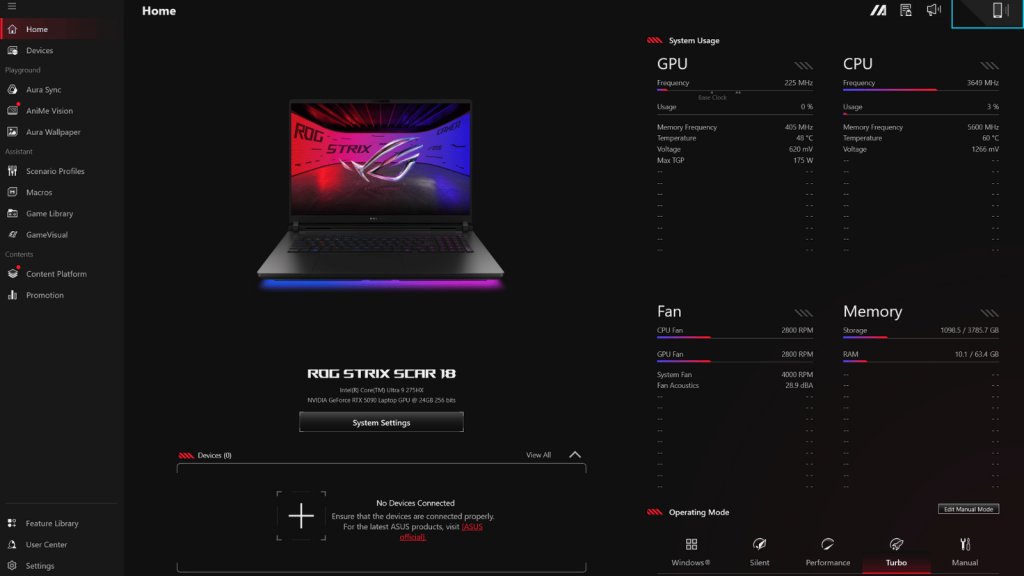
As we said in the intro, this gaming beast packs some of the fastest chips available to deliver seriously impressive performance. The Intel Core Ultra 9 275HX found inside has a total of 24 cores (8 performance, 16 efficiency), and can chug up to 175W of power for short bursts or 150W in sustained workloads.
It is a very capable laptop CPU, which was evident during our benchmarks, but we couldn’t help but wonder how much more gaming performance you’d get from an equivalent AMD CPU, like the Ryzen 9 9955HX.
Show me the numbers (CPU):
-
Cinebench 24 (Single core) avg – 127
-
Cinebench 24 (Multi-core) avg – 1,989
-
Geekbench 6.4 (Single core) avg – 1,602
-
Geekbench 6.4 (Multi-core) avg – 17,016
The Nvidia RTX 5090 laptop GPU delivered similarly impressive performance. This chip comes with a sizeable 24GB of VRAM and can reach a max clock speed of 2,340 MHz while also chugging down 175W of power when plugged in. We didn’t see clock speeds ever get that high, but its performance was plentiful nonetheless.
Asus provides three power profiles inside Armoury Crate – quiet, performance, and turbo. There’s also the option to manually overclock the CPU and GPU and adjust the fan curves if you’re into that. We stuck with the turbo profile to mimic the performance the average user would see.
More numbers (GPU):
-
3DMark Steel Nomad avg – 5,788
-
3DMark Time Spy Extreme avg – 11,790
-
PCMark 10 avg – 7,144
We also put it through its paces in a few games to see what gaming performance was like. Unsurprisingly, it handled all of them with aplomb. We assumed, as this is a laptop GPU, that we’d have no choice but to dilute any gameplay with Nvidia’s upscaling tech, but that wasn’t always the case.
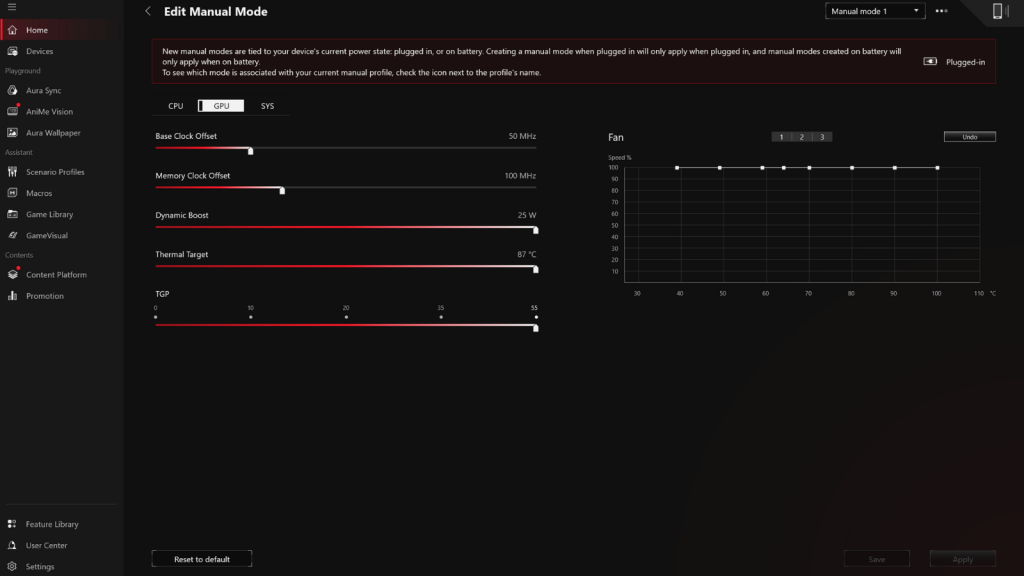
In The Last of Us: Part 2 Remastered, it managed a stable 60fps with a mix of medium and high settings with no upscaling or AI-powered frame generation. It was only when we maxed out all the settings that we felt the need to enable DLSS to keep gameplay smooth.
In Cyberpunk 2077, we couldn’t quite manage the same feat. With maxed settings and DLSS and frame gen disabled, we only saw an average of around 40fps. That doesn’t cut it as playable in our book, no matter what the 30fps-loving console plebs tell you. However, with the same maxed-out settings, including path-traced rays enabled, and relatively tame DLSS and frame gen settings, we saw an average of just over 70fps.
During these synthetic tests and while gaming, we found CPU temperatures hovered around the 95° mark with the GPU sitting comfortably at 85°. We didn’t see any thermal throttling, thanks to the Scar 18’s comprehensive cooling solution. There are three fans inside that suck air in through the bottom and sides and direct it over the ‘sandwiched’ heatsink and end-to-end vapour chamber and out through the vents at the rear, keeping it away from your hands.
It’s worth noting that, in order to achieve this, those three fans need to move a lot of air and so spin rather quickly. During gaming sessions, or anything activity that requires a lot of power, you’ll need to don your headphones if you hope to hear your team’s callouts or what anyone is saying on screen.
Got the juice?
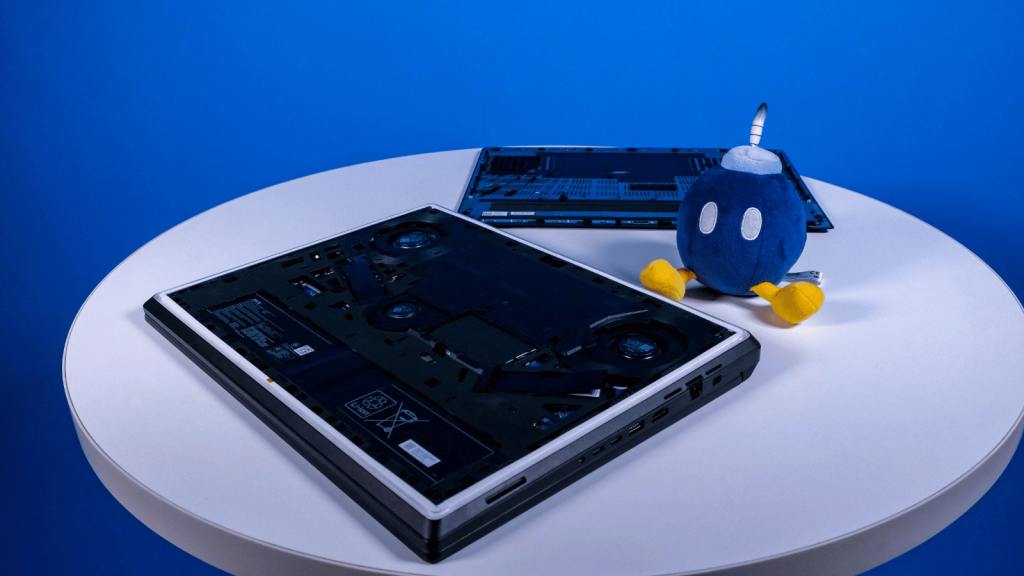
Despite the large 90Wh battery inside, don’t expect much in the way of longevity if you’re doing anything intensive. In our battery tests, we got just over five and a half hours while streaming with the screen set to 50% brightness and all RGB turned off.
In a more typical scenario, with Bluetooth headphones connected and the screen set to max brightness, that time was reduced to just under four and a half hours. We also tried gaming while on battery but then you’re left with a fraction of the performance (the CPU and GPU are both power limited) and we still only saw about 45 minutes of gameplay before it moaned at us to plug it in.
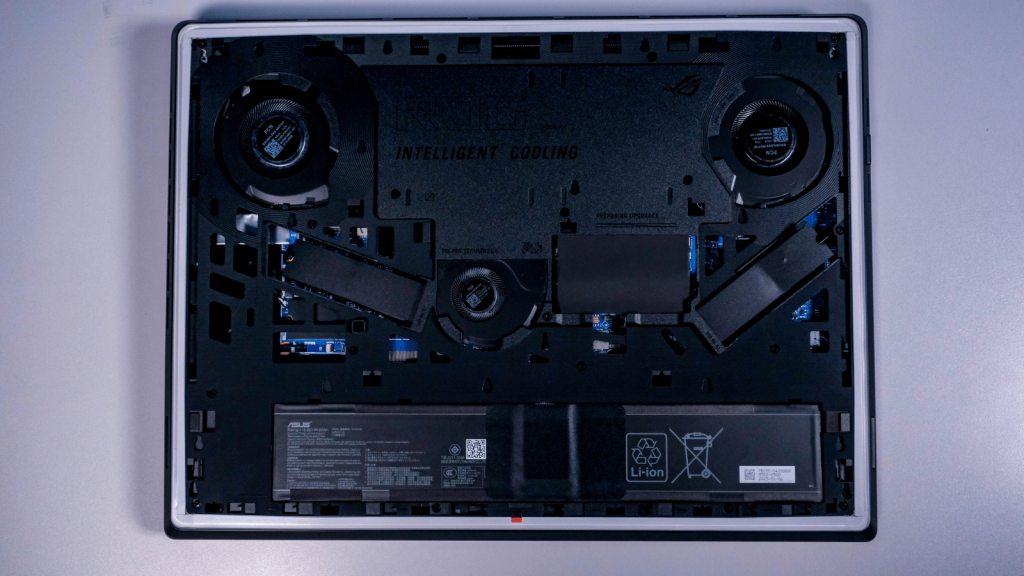
There were only two aspects of the Scar 18 that we didn’t love. First, we can’t help but think it would’ve been a better option to spec it out with a single PCIe Gen 5 SSD instead of the dual 2TB Gen 4 drives you get here. They’re set up in a RAID 0 to boost read and write speeds, and while it’s always cool to say you’re using RAID 0, similar results should be possible with a single Gen 5 drive. That would also eliminate the potential for data loss – RAID 0 means that if one drive fails, all your data is gone.
The second thing was the RAM. Our review unit came with both SO-DIMM slots occupied with 32GB sticks. If you’re looking to do design work, 64GB of RAM over 32GB can make a big difference. Unfortunately, it doesn’t appear that consumers can purchase the Scar 18 with 64GB out of the box. They’ll have to drop R100k on the laptop and then another wad of cash to upgrade it themselves. Thankfully, Asus have made that, and any other maintenance tasks, a lot simpler with the toolless bottom tray.
ROG Strix Scar 18 verdict
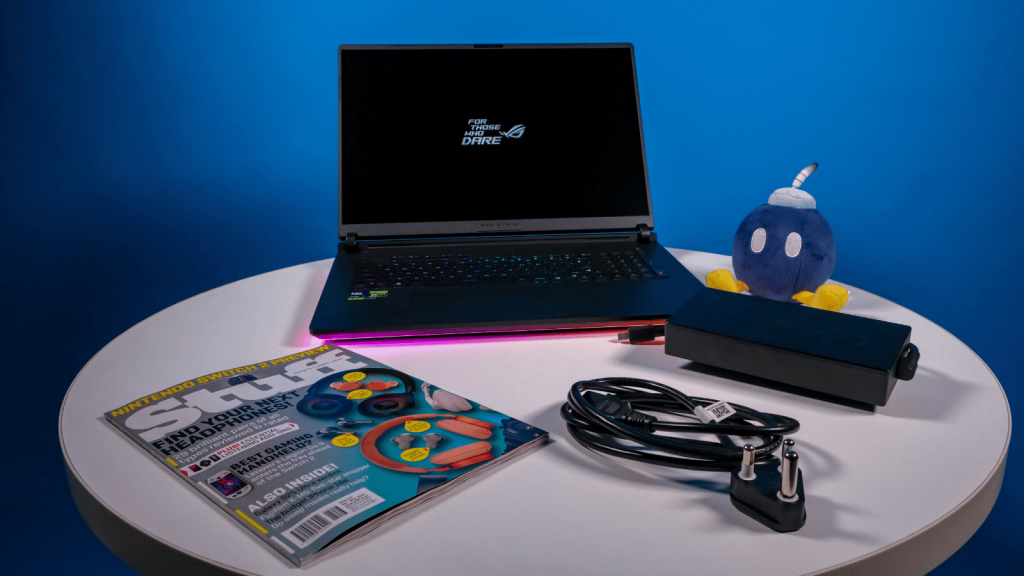
Yes, R100,000 for a laptop is a lot of money. But the ROG Strix Scar 18 is one of the most powerful laptops you can buy anywhere and certainly the most powerful we’ve reviewed (so far). For your money, you get a decent-looking gaming beast that will chew through any intensive design, content creation, and gaming workloads you throw at it. It gets loud, sure, but it won’t melt.
With this much performance from a laptop, you can’t really expect more than that. A similarly specced desktop will have more power but it will also use more power, cost more, and will be a headache to take anywhere with you. If you want the best mobile performance, and can stomach the price tag, the ROG Strix Scar 18 should be at the top of your wishlist.
Crédito: Link de origem


